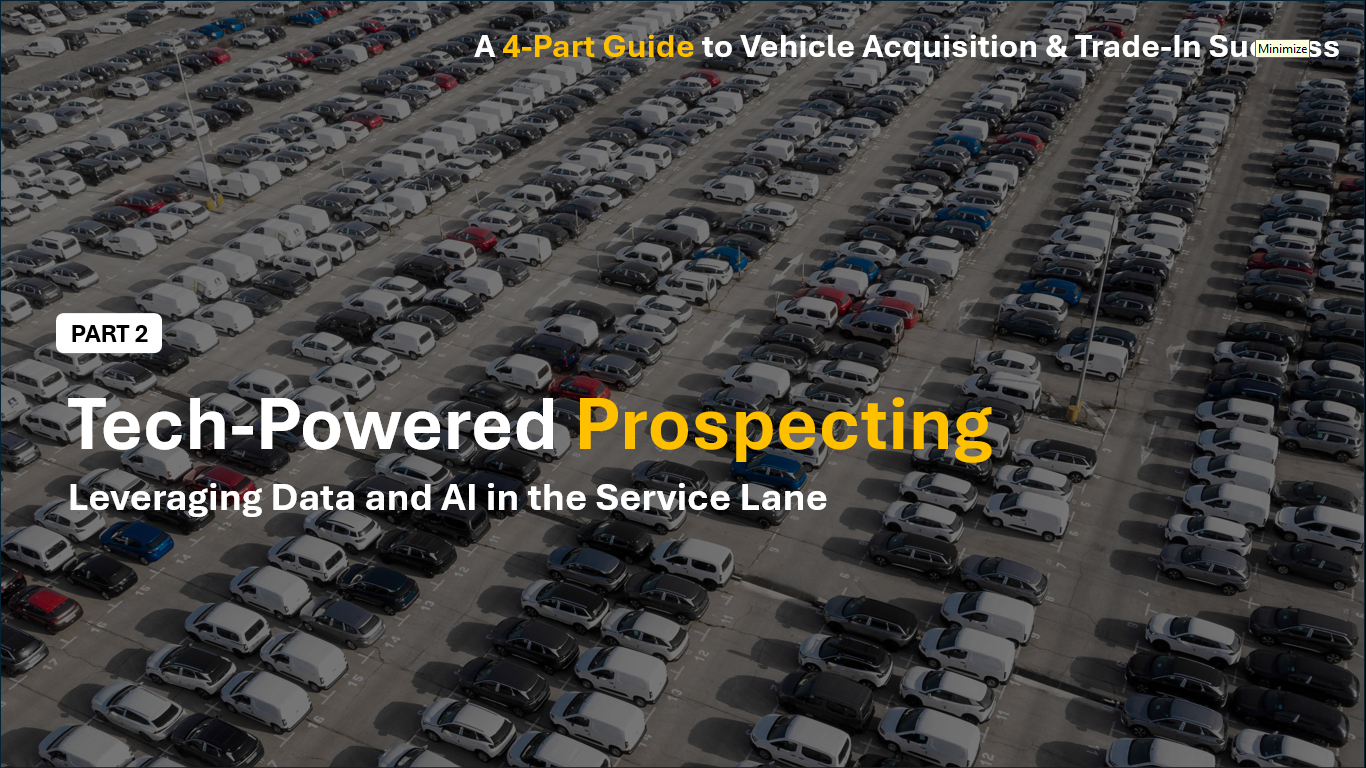
In Part 1, we established that your service drive is an untapped goldmine for vehicle acquisitions. We talked about understanding the service customer and the art of traditional engagement. Now, let’s shift gears and explore how technology, specifically your existing data and emerging Artificial Intelligence (AI) tools, can supercharge your efforts, turning good intuition into great, data-driven results.
The key here isn’t to replace your skills but to amplify them. Think of these technologies as your new, incredibly smart assistant, helping you identify the hottest prospects before they even think of raising their hand.
Experienced salespeople develop a fantastic “gut feeling” for potential opportunities. You see a customer with an older vehicle and a concerned look while discussing repair costs, and your internal alarm bells for a potential trade-in start ringing. That’s invaluable.
But what if you could systematically analyze every service customer against dozens of factors simultaneously? That’s where data and AI come in. AI can sift through mountains of information – vehicle age, mileage, repair frequency, equity position, past interactions, even current market demand for their specific model – to pinpoint customers who are statistically most likely to be ready for a change. This allows you to focus your expertise on the most promising conversations, making your time in the service lane incredibly efficient. It’s about moving from hoping for an opportunity to proactively engaging with data-qualified ones.
This might mean a slight shift in how you approach your day. Instead of just relying on who you happen to bump into, you might start your morning by reviewing a list of AI-flagged service appointments. It’s about adding a layer of precision to your proven instincts.
Before you even think about fancy new AI software, let’s talk about the power you already have at your fingertips: your Customer Relationship Management (CRM) and Dealer Management System (DMS). These systems are more than just digital filing cabinets; they are goldmines of customer and vehicle data.
Here’s what you should be looking for:
Even without advanced AI, you can start using this data more intelligently. Work with your manager to run reports: “Show me all service customers this week whose vehicles are over X years old and have had repair orders totaling Y dollars in the past year.” This simple step can give you a focused list to start with. Getting your data house in order now will make any future AI tools you adopt infinitely more powerful.
With a solid data foundation, AI tools can take your service drive prospecting to a whole new level. These aren’t futuristic concepts; many are available and being used by dealerships today:
These AI tools help shift your strategy from generalized approaches to precise, data-driven engagements, significantly boosting your efficiency and success rate.
To make your AI even smarter, consider the power of Application Programming Interfaces (APIs). Think of APIs as secure messengers that let different software systems talk to each other and share data automatically.
Integrating these APIs means more accurate appraisals, a clearer picture of customer equity, and the ability to spot service-related trade triggers (like an open recall on an aging vehicle). The European Automobile Manufacturers’ Association (ACEA) is even pushing for unified data spaces to make this easier. Some are even looking at blockchain for secure data sharing.
An AI tool that can access live vehicle diagnostic data from an OEM API , current market values, and detailed service history from the DMS is far more powerful than one working in a silo.
To bring this all together, here’s how these data points and AI tools can translate into real-world actions for you in the service drive:
Table 1: Mapping Service Drive Opportunities: Data Points & AI Applications
| Customer/Vehicle Situation | Key Data Points to Analyze | Potential AI Tool/Application | Key Sales Personnel Action |
| Aging Vehicle (e.g., 7+ years) + High Repair Est. | Vehicle Age/Mileage, Repair History & Costs, Est. Market Value, Previous Purchase Cycle | Predictive Trade-in Scoring; AI Equity Calc; Automated Alert to Sales | Proactively approach, offer equity review, discuss benefits of trading (avoid repairs, new warranty), show newer models. |
| End of Lease Approaching (6-9 months) | Lease End Date, Current Mileage, Vehicle Condition (from service walk-around) | AI Lease-End Offer Generation; Personalized Marketing for New Options; Chatbot for Consult Scheduling | Initiate contact about lease-end options. Use AI offers as a starting point. Highlight loyalty benefits. |
| Frequent/Recurring Service Issues | Service Frequency, Repair Types, Component Failure Patterns, Warranty Status | AI Anomaly Detection in Service Patterns; Predictive Failure Analysis | Express empathy. Discuss reliability. Offer a “peace of mind” trade-in towards a more reliable vehicle. |
| Expressed Interest in New Features (CRM Note) | CRM Notes (e.g., “wants EV range”), Current Vehicle Lacks Feature | AI Personalized Vehicle Recommendation; Automated Email/SMS on Models with Feature | Follow up: “Recall you were interested in [feature]? We have new models with that. Like to see them post-service?” |
| High Demand Vehicle + Positive Equity | Market Demand Data, Est. Trade Value vs. Payoff, Vehicle Condition, Desirable Options | AI Equity Mining Tool; Real-Time Market Pricing Suggester | Inform customer of strong demand: “Your [Make Model] is hot! You likely have significant equity. Top-dollar offer today if considering an upgrade.” |
| Service Customer Browsing Inventory Online | Website Activity (pages viewed, time on vehicle), Link to Service Appt. via CRM | AI Behavioral Analytics linking online/offline; Personalized Pop-up/Chatbot on website | If known customer, follow up on viewed inventory: “Saw you looking at the new [Model] online. We have one here if you’d like a look after your service.” |
In Part 3: Ethical & Compliant Acquisition, we’ll tackle the critical rules of the road – navigating AI regulations, data privacy, and ensuring fairness in all your tech-powered prospecting.
